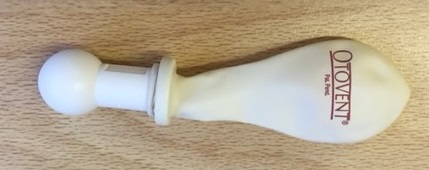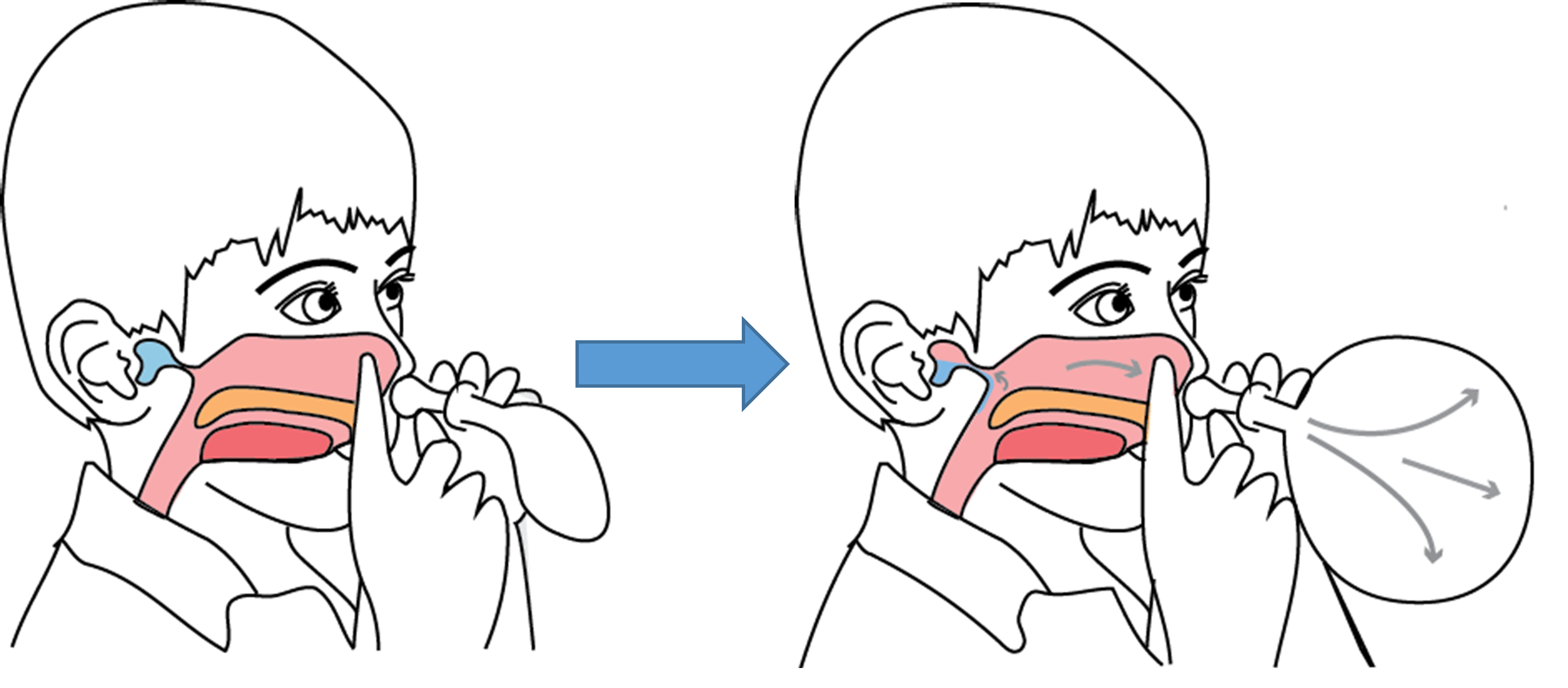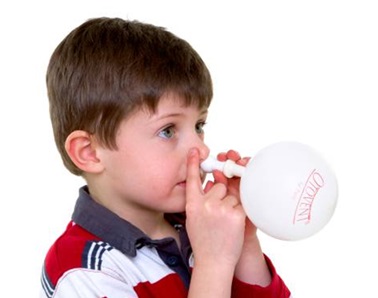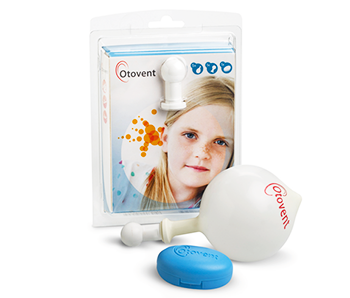Nasal balloon treatment
Your child's doctor, nurse or audiologist may prescribe treatment with a nasal balloon to help clear your child's glue ear during the watchful waiting period.
Treatment involves your child blowing up a medical balloon with their nose 3 times a day for 1 to 3 months or until the fluid has cleared and their hearing has returned to normal.
The treatment is suitable for children from about the age of 4 years old, although children as young as 3 have been reported as able to inflate the nasal balloon.

How does it work?
The pressure of blowing a balloon up with the nose opens the Eustachian tubes. This lets air in to the middle ear and allows fluid to drain out. Regular nasal balloon treatment can help your child's hearing to return to normal.
What is the evidence?
- Recent research has found that children who use the nasal balloon were 40% more likely to have their ears cleared of fluid after 1 month compared to children who had watchful waiting alone.
- Children who use the nasal balloon also had fewer days with symptoms and better quality of life than children who had watchful waiting after 3 months.
How often do they need to inflate the balloon?
The balloon needs to be inflated 3 times per day in each nostril, for example in the morning, after school and before bed. It is good to try and make blowing up the balloon part of your child's daily routine like when they are cleaning their teeth.
Are there any side effects?
Your child might notice a popping or clicking sound when they blow up the nasal balloon, especially the first time. These effects are normal and can indicate that the Eustachian tubes are opening and the treatment is working. (The effect is similar to equalising pressure in your ears when on an aeroplane).
Runny noses have been reported in a small number of children using the nasal balloon.
When should my child NOT use the nasal balloon?
Ear infection: The nasal balloon should not be used if your child has an ear infection.
Cold or blocked nose: if your child develops a cold or blocked nose it is best to stop the balloon for a few days until their airways clear, and then start up again.
Nasal balloon instructions
The nasal balloon comes in a treatment pack (Otovent) containing 5 medical balloons, a connecting nozzle and a small carrying case.
Watch a video demonstration of nasal balloon autoinflation here (1min 26secs):
Step by step instructions:
- Take one of the balloons and stretch it using your hands or blow it up with your mouth to release some of the tension, otherwise the first inflation may be quite difficult.
- Attach the balloon to the connecting nozzle.

- To make sure your child understands what they need to do either show them the instruction video or demonstrate the nasal balloon yourself.
- Ask your child to hold the nozzle up to one nostril and close off the other nostril with their fingers.
- Instruct your child to keep their mouth closed, slowly blow out of the nose and inflate the balloon to about the size of a large orange. Repeat with the other nostril.

- Give lots of feedback and encouragement. Using a sticker chart can help you and your child to remember to use the balloon regularly (download sticker chart here)
What do parents say?

Parents of children who took part in a research study at University of Southampton were interviewed about the nasal balloon. Here are some of their experiences:
What did parents say about the nasal balloon?
Most parents and children liked the idea of trying a nasal balloon to treat glue ear and children found it fun to do:
- One mother of a 5 year old boy said "it looked quite a simple thing to use and – he just got on with it. He loved it, you know, it was a great thing, a five-year-old boy trying to blow up a balloon with his nose"
- Another parent agreed: " well the girls thought that was great fun, anything to do with balloons!"
What helped them remember to use the nasal balloon?
Parents said that making the nasal balloon treatment part of their daily routine was helpful. The children liked using a sticker reward chart as a reminder (you can download a sticker reward chart here)
- Parent of 6 year old boy commented: "in the morning whatever we were doing, and then at bedtime, so it was just like cleaning your teeth, just brought it in as an extra thing to do as part of the routine”
- Parent of 4 year old boy commented: “he was – really happy to be down here: let me mark off, let me put the sticker on – and so we never had no problems with it. In fact he was reminding me – mum, I haven't done it, I haven't done my balloon”
Did families have any problems using the nasal balloon?
Some parents reported that their children had problems with the first inflation. Pre-stretching really helps with releasing some of the tension and to keep trying.
-
Parents of a 6 year old boy said: "He did struggle to start with, but it wasn't long before he could get it to an orange"
-
Another parent agreed "my son was quite shy to do it at first. But when we got home of course it's like a new toy so he was all over it"
Other parents reported problems continuing treatment over a longer period. Parents tried to make the treatment fun for the children:
- One parent commented: "We made a joke out of it; it was a bit of a game really - to see who could blow the biggest balloon"
- Mother of a 4 year old girl said: " It got tricker as time went on because she got fed up with it and she was saying she didn't want to do it anymore. But i kept encouraging her and gave her sticker rewards and she managed to finish the treatment"
FAQ - nasal balloon treatment

Where can I get a nasal balloon?
The nasal balloon (Otovent) is available on prescription from your child's GP or can be purchased from the chemist or from the internet.
How often do they need to inflate the balloon?
The balloon needs to be inflated 3 times per day in each nostril, for example in the morning, after school and before bed. It is good to try and make blowing up the balloon part of your child's daily routine like when they are cleaning their teeth.
How do your know when to change the balloon?
The balloon should be changed every week, or when it seems to have lost tension (your child may report that it is no longer working). The nozzle can be wiped with an antiseptic/baby wipe or washed in warm soapy water.
Are there any side effects to the nasal balloon?
Your child might notice a popping or clicking sound when they blow up the nasal balloon, especially the first time. These effects are normal and can indicate that the Eustachian tubes are opening and the treatment is working.
Runny noses have been reported in a small number of children using the nasal balloon.
When should my child NOT use the nasal balloon?
The nasal balloon should not be used if your child has an ear infection or if they have a latex allergy.
If they have a cold or blocked nose, it is probably best to stop the balloon for a few days until their airways clear, and then start up again.
How can you help your child manage the nasal balloon?
Give lots of encouragement when your child blows the balloon up for the first time. Sometimes they will only manage a small inflation but this can be enough to have a treatment effect. Most children can manage it with some practice .